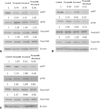Pazopanib synergizes with docetaxel in the treatment of bladder cancer cells
- PMID: 21529900
- PMCID: PMC3126899
- DOI: 10.1016/j.urology.2011.02.041
Pazopanib synergizes with docetaxel in the treatment of bladder cancer cells
Abstract
Objectives: To investigate the efficacy of pazopanib, both alone and in combination with docetaxel, in bladder cancer cells. Bladder cancer expresses many potential therapeutic targets of biological agents, including the vascular endothelial growth factor receptor (VEGFR). Pazopanib is a small molecule inhibitor of VEGFR-1, -2-3, platelet-derived growth factor receptor (PDGFR), and c-Kit.
Materials and methods: Using human bladder cancer cells HTB3, HT1376, J82, RT4, CRL1749, T24, Sup, and HTB9, the treatment effect of pazopanib and cytotoxic chemotherapy was assessed using a tetrazolium-based assay. The combinatorial effect of these agents on clonogenic growth was further examined. Western blotting was used to assess changes in relevant downstream targets, including phospho-AKT, phospho-FAK, total AKT, and total FAK.
Results: Single-agent pazopanib had modest activity. However, synergy was seen with the combination of docetaxel and pazopanib in these multiple cells lines. J82 and T24 cells were selected for additional clonogenic testing because of their resistance to single-agent docetaxel chemotherapy. 1.25 nM of docetaxel had little effect on clonogenic formation; however, in combination with pazopanib, significant inhibition of colony formation was observed. This combination treatment additionally decreased phospho-AKT, an important mediator of cell survival in all cell lines, whereas phospho-FAK expression was variably affected.
Conclusions: The present study demonstrates synergistic efficacy of pazopanib with docetaxel in docetaxel-resistant bladder cancer cells. This work supports future evaluation of pazopanib with docetaxel for the treatment of bladder cancer with the potential of improved efficacy and toxicity.
Copyright © 2011 Elsevier Inc. All rights reserved.
Figures



Similar articles
-
Dual epidermal growth factor receptor and vascular endothelial growth factor receptor inhibition with vandetanib sensitizes bladder cancer cells to cisplatin in a dose- and sequence-dependent manner.BJU Int. 2009 Jun;103(12):1729-37. doi: 10.1111/j.1464-410X.2009.08367.x. Epub 2009 Feb 10. BJU Int. 2009. PMID: 19220256
-
Assessment of Predictive Biomarkers of the Response to Pazopanib Based on an Integrative Analysis of High-grade Soft-tissue Sarcomas: Analysis of a Tumor Sample from a Responder and Patients with Other Soft-tissue Sarcomas.Clin Orthop Relat Res. 2020 Nov;478(11):2461-2476. doi: 10.1097/CORR.0000000000001322. Clin Orthop Relat Res. 2020. PMID: 32567826 Free PMC article.
-
Impact of pazopanib on docetaxel exposure: results of a phase I combination study with two different docetaxel schedules.Cancer Chemother Pharmacol. 2015 Feb;75(2):365-71. doi: 10.1007/s00280-014-2655-x. Epub 2014 Dec 23. Cancer Chemother Pharmacol. 2015. PMID: 25533184 Clinical Trial.
-
Vascular endothelial growth factor (VEGF) targeting therapy for persistent, recurrent, or metastatic cervical cancer.Cochrane Database Syst Rev. 2021 Mar 4;3(3):CD013348. doi: 10.1002/14651858.CD013348.pub2. Cochrane Database Syst Rev. 2021. PMID: 33661538 Free PMC article.
-
Pazopanib for the treatment of renal cancer.Expert Opin Pharmacother. 2011 May;12(7):1171-89. doi: 10.1517/14656566.2011.571206. Epub 2011 Apr 7. Expert Opin Pharmacother. 2011. PMID: 21470066 Review.
Cited by
-
Pazopanib and sunitinib trigger autophagic and non-autophagic death of bladder tumour cells.Br J Cancer. 2013 Aug 20;109(4):1040-50. doi: 10.1038/bjc.2013.420. Epub 2013 Jul 25. Br J Cancer. 2013. PMID: 23887605 Free PMC article.
-
The combination of everolimus and terameprocol exerts synergistic antiproliferative effects in endometrial cancer: molecular role of insulin-like growth factor binding protein 2.J Mol Med (Berl). 2018 Nov;96(11):1251-1266. doi: 10.1007/s00109-018-1699-5. Epub 2018 Oct 8. J Mol Med (Berl). 2018. PMID: 30298385
-
Bone Metastasis in Bladder Cancer.J Pers Med. 2022 Dec 27;13(1):54. doi: 10.3390/jpm13010054. J Pers Med. 2022. PMID: 36675715 Free PMC article. Review.
-
New therapeutic targets in the management of urothelial carcinoma of the bladder.Res Rep Urol. 2013 Mar 1;5:53-65. doi: 10.2147/RRU.S29131. Res Rep Urol. 2013. PMID: 24400235 Free PMC article.
-
Pathological response in children and adults with large unresected intermediate-grade or high-grade soft tissue sarcoma receiving preoperative chemoradiotherapy with or without pazopanib (ARST1321): a multicentre, randomised, open-label, phase 2 trial.Lancet Oncol. 2020 Aug;21(8):1110-1122. doi: 10.1016/S1470-2045(20)30325-9. Epub 2020 Jul 20. Lancet Oncol. 2020. PMID: 32702309 Free PMC article. Clinical Trial.
References
-
- Jemal A, Siegel R, Ward E, Hao Y, Xu J, Thun MJ. Cancer statistics, 2009. CA Cancer J Clin. 2009;59:225–249. - PubMed
-
- von der Maase H, Sengelov L, Roberts JT, Ricci S, Dogliotti L, Oliver T, Moore MJ, Zimmermann A, Arning M. Long-term survival results of a randomized trial comparing gemcitabine plus cisplatin, with methotrexate, vinblastine, doxorubicin, plus cisplatin in patients with bladder cancer. J Clin Oncol. 2005;23:4602460–4602468. - PubMed
-
- Sternberg CN, Yagoda A, Scher HI, Watson RC, Ahmed T, Weiselberg LR, et al. Preliminary results of M-VAC (methotrexate, vinblastine, doxorubicin and cisplatin) for transitional cell carcinoma of the urothelium. J Urol. 1985;133:403–407. - PubMed
-
- Hussain M, Vaishampayan U, Du W, Redman B, Smith DC. Combination paclitaxel, carboplatin, and gemcitabine is an active treatment for advanced urothelial cancer. J Clin Oncol. 2001;19:2527–2533. - PubMed
-
- McCaffrey JA, Hilton S, Mazumdar M, Sadan S, Kelly WK, Scher HI, et al. Phase II trial of docetaxel in patients with advanced or metastatic transitional-cell carcinoma. J Clin Oncol. 1997;15:1853–1857. - PubMed
Publication types
MeSH terms
Substances
Grants and funding
LinkOut - more resources
Full Text Sources
Medical
Molecular Biology Databases
Miscellaneous

